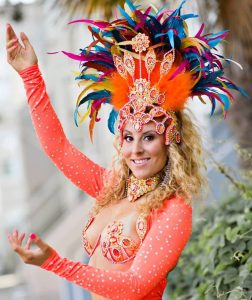By Lindenberg Junior
Translation: Christine Di Stefano
Despite some similarities, Samba and Jazz have distinctively different origins and line of development. One of the factors that add to this is that Brazilian slave owners allowed their slaves to continue their heritage of playing drums, unlike some U.S. slave owners, who feared the use of the drum for communication. “Pelo Telefone,” a song written by Donga and Mauro Almeida in 1917, is generally, considered the first samba recording and its great success carried the new genre outside the “favelas” in Rio.
Samba is a musical genre derived from African and European roots, created a developed in Brazil in the beginning of 20th century in Rio de Janeiro. The Samba has achieved worldwide recognition as a symbol of Brazil and the Brazilian Carnival.
Modern Samba was developed from an earlier Brazilian musical style called Choro and that has taken many different formats over the years; from the vivacious call and response of samba de enredo – the music of Carnaval Parade & Samba Schools, to a more relaxed guitar and rhythm variant. Bossa Nova, which translates to new wave, hit America big time in the Sixties with “The Girl from Ipanema” by legendary composer Antonio Carlos Jobim, which became a jazz classic and elevator music.
In the early 1980s, after having been eclipsed by the popularity of “Disco” and the new “Brazilian Rock,” Samba reappeared in the media with a musical movement created in the suburbs of Rio de Janeiro called “Pagode” – a renewed samba, with new instruments like the Banjo and the Tam-Tam. Samba, as a result, morphed during this period, embracing types of music that were growing popular in the Caribbean such as Reggae and other rhythmus already famous around the globe such as rap.
Examples of Samba fusions with other popular music are the sambarap and samba-reggae, all of which were efforts music to not only entertain but to unify all Blacks throughout the Americas, culturally and politically, through song.
Samba continued to act as a unifying factor during the 90’s and 2000`s not only in Brazil, but in many countries around the globe, as here in U.S., as in Japan, Australia, Canada Europe, and even in Russian and China. During the last two decades, “sambistas” of all ethnicities have spread fast and have become real ambassadors for the samba dissemination.
We conclude this article by making homage to the many “Samba Dancers” in the U.S. They are Brazilians, Portuguese, Americans, Colombian, Canadian, Mexicans, Argentinean, Jamaicans, Israeli, etc.

